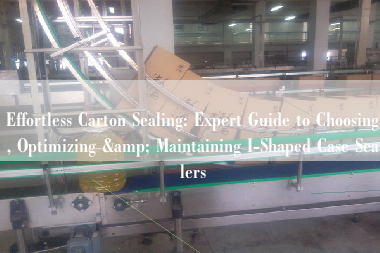Definition and Working Principle
An I-shaped case sealer is an automated machine designed to securely seal cartons using adhesive tape applied in an “I” pattern. This pattern involves a single strip of tape placed along the center seam of the carton flap, creating a reliable seal that protects contents during handling and transit. The working principle begins with cartons entering the machine via a conveyor belt. Sensors detect the carton position, triggering the tape application system. A dispenser unrolls and cuts the tape, pressing it firmly onto the flap’s center seam. Pressure rollers then ensure adhesion, completing the seal without manual intervention. This process operates at high speeds, handling cartons of various sizes with precision.
Application Scenarios and Advantages
I-shaped case sealers excel in industries requiring efficient carton sealing, such as food processing, pharmaceuticals, and consumer goods. They handle standard shipping cartons for products like packaged foods, medical supplies, and electronics. Key advantages include labor cost reduction by automating repetitive tasks, increased throughput with speeds up to 30 cartons per minute, and consistent seal quality that minimizes product damage. This automation supports compliance with hygiene standards in sensitive sectors, enhancing overall packaging line reliability.
Common Types and Basic Components
Common types of I-shaped case sealers include automatic models for high-volume production lines and semi-automatic versions for smaller operations. Variations exist based on carton size adaptability and integration capabilities. Basic components comprise the conveyor system for carton transport, the tape dispenser unit for applying adhesive tape, cutting mechanisms for precise tape separation, pressure rollers for seal integrity, and a programmable control panel for adjustments. These elements work in unison to deliver versatile, robust performance across diverse packaging environments.

Selecting and Optimizing Your I-Shaped Case Sealer
Choosing the Optimal I-Shaped Case Sealer for Cartons
Production volume dictates machine selection. Low-volume operations (under 15 cartons/minute) benefit from semi-automatic models requiring manual box placement. Fully automatic systems handle 25-30 cartons/minute for high-throughput facilities. Evaluate carton dimensions: Standard sealers accommodate 8-24 inch widths, while adjustable-arm models manage irregular sizes like tapered cosmetic boxes. Assess material compatibility – corrugated cardboard requires different pressure settings than double-wall shipping containers. Integration potential matters; units with standardized PLC interfaces connect seamlessly to upstream Case Packers and downstream Palletizers.
Critical Selection Metrics: Performance, Efficiency, Cost
Throughput capacity directly impacts ROI. Calculate required cycles per minute against labor costs saved. A 25-carton/minute sealer replaces 3-4 manual workers. Evaluate energy consumption: Brushless servo motors reduce power usage 40% versus traditional drives. Analyze changeover times – quick-release mechanisms for tape heads and tool-free height adjustments minimize downtime during product transitions. Total ownership costs include consumables: Pre-cut tape rolls lower waste compared to bulk systems. Sealing success rates above 98% prevent costly rework.
Operational Optimization Techniques
Calibrate pressure rollers based on carton thickness: 15-20 PSI for standard corrugated boxes versus 25-30 PSI for reinforced materials. Match tape specifications to environmental conditions: Acrylic adhesives maintain integrity in refrigerated facilities, while hot-melt tapes suit humid climates. Programmable logic controllers store settings for different carton profiles – recall parameters with one-touch operation. Position infrared sensors at 45-degree angles to detect box seams accurately during high-speed operation. Implement anti-jam protocols: Conveyor gaps should measure 1.5x carton length to prevent collisions. Schedule weekly roller cleaning with isopropyl alcohol to maintain adhesive transfer efficiency.
Maintenance and Troubleshooting Guide for I-Shaped Case Sealers
Daily Maintenance Steps and Best Practices
Perform daily cleaning of adhesive rollers using isopropyl alcohol to prevent residue buildup that affects tape adhesion. Inspect tape heads for wear or misalignment; replace worn blades immediately to maintain sealing integrity. Check conveyor belts for debris or damage, clearing obstructions with compressed air. Verify sensor functionality by running test cartons through the system. Lubricate moving parts like guide rails weekly with manufacturer-approved greases to reduce friction. Document all maintenance activities in a logbook to track performance trends. Train operators to conduct visual inspections at shift start, focusing on tape application consistency and box positioning. Implement a shutdown procedure that includes powering off and securing safety guards after each use.
Common Fault Diagnosis and Solutions
Diagnose tape sealing failures by examining adhesive transfer: Poor adhesion may indicate contaminated rollers or incorrect pressure settings. Adjust roller pressure to 15-30 PSI based on carton thickness, and clean rollers if residue is present. Address conveyor jams by checking for box collisions; ensure gaps measure 1.5x carton length and recalibrate infrared sensors if misalignment occurs. Resolve sensor errors through diagnostic tests: Reposition sensors at 45-degree angles for optimal seam detection, and replace faulty units if unresponsive. Fix misfed tape issues by verifying tension settings and replacing depleted rolls. Handle motor malfunctions by inspecting electrical connections and consulting error codes on the PLC interface. Solutions include resetting the system, tightening connections, or scheduling professional repairs for persistent problems.
Preventive Maintenance Strategies and Long-term Care Suggestions
Establish a preventive maintenance schedule with quarterly deep cleanings and semi-annual part replacements, such as rollers and blades, to avoid unexpected downtime. Monitor machine performance via PLC data logging to identify wear patterns early. Maintain an inventory of critical spare parts like tape heads and sensors for rapid replacements. Conduct annual audits by certified technicians to assess alignment and efficiency. For long-term care, upgrade software regularly to leverage new features and improve compatibility with upstream Case Packers. Train staff annually on advanced troubleshooting to extend equipment lifespan. Implement environmental controls, such as humidity monitoring in packaging areas, to protect components from corrosion. Partner with Yanmao for customized service plans that support sustained operation over decades.
